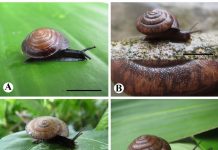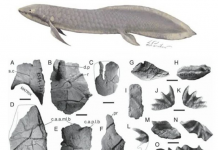Millipedes are a group of arthropods, as insects, crustaceans, crabs and spiders with an exoskeleton. The millipede is the animal with the largest number of legs in the world. Although the name “millipede” derives from the Latin for “thousand feet”, no known species has 1,000; the record of 750 legs belongs to Illacme plenipes Cook & Loomis, 1928. There are more than 12,000 species of millipedes worldwide in a variety of body shapes and sizes, ranging from 2 mm (0.08 in) to around 35 cm (14 in) in length.
Millipedes are an essential part of the nutrient cycle; they are decomposers helping turn the natural world’s debris back into usable nutrients. Their mouth is evolved to suit for being a consumer of plant debris, thus making them impossible to bite or harm humans, unlike centipede. Plus, their body has an ozopore hole inside the glands that produce chemicals such as benzoquinone and cyanide compounds to repel enemies or communicate with each other.
Millipedes generally reproduce by the method of sexual reproduction. There is a genital opening in the female reproductive organ in the third segment. Males possess one or two pairs of modified legs called gonopods which are used to transfer sperm to the female during copulation. The location of the gonopods differs between groups: in males of the Pentazonia, they are located at the rear of the body and known as telopods and may also function in grasping females, while in the Helminthomorpha – the vast majority of species – they are located on the seventh body segment. These auxiliary organs are structurally different for each species. It is also a popular morphology used to classify millipede species.
Millipedes are the primary consumer of the food chain, allowing them a vital energy source for higher-order predators. Although millipedes can curl up and release chemicals for self-defence, there are a number of enemies that can hunt them. For example, birds can peck through their body-wall. Reptiles and amphibians can feed on millipedes as a whole. Some kind of ants has specialised jaws to remove millipede hairs before consuming their prey. Besides, predators with exceptionally hard and sharp mouth appendages are able to pierce through the thick and hard shell of the millipedes and feed on the liquid inside the millipede.
Millipedes can be found in a wide variety of ecosystems. They typically live in leaf litter, deadwood, or soil, with a preference for humid conditions. Especially in the limestone hills, millipedes can be found in various species. While millipedes are considered decomposers, some species are devastating to agricultural produce by feeding on the growing roots. In Thailand, there has been news of an outbreak or invasion of millipedes into houses that causing people to panic. In addition, Thai people believe that millipedes can bite and lay eggs in their bite wound, causing most people to hate and fear them. Of course, that was incorrect belief, since the millipede’s mouth had no sharp fangs, unable to bite or hurt people as understood.
Millipedes are an important part of the nutrient cycle; they are decomposers helping turn the natural world’s debris back into usable nutrients. Inside the gut of the millipede, there are large amounts of debris-digesting microorganisms, making tiny bolus-like droppings increase the number of beneficial microorganisms in nature. Millipedes are like a mobile fertilizer factory, doing this vital work tirelessly. It is estimated that millipedes contribute up to 10% of all fallen plant debris in natural forests.
Millipedes have been studied in Thailand since 2006. There are 91 additional new millipede’s species discovered in Thailand, 105 of which were previously reported, showing the biodiversity of millipedes in Thailand and Southeast Asia region. This study is just the starting point for opening up the world of millipede knowledge in various aspects, which will lead us to the efficient and sustainable management of biological resources in the future.






